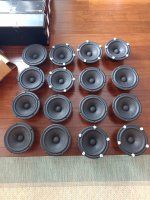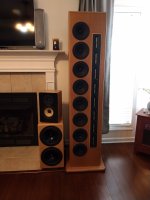I'm sure you're rightAnd the final arbiter is the market - the best survey is a signed purchase order.
Just scanning this patent this is about electronic driver excursion correction and not about driver design. Many Subwoofer do that is some form and Devialet has an DSP option to correct low frequency of many different loudspeakers called SAM (speaker aktive matching) which is apparently a feed forward implemented based on speaker measurements and not sensors like in many subwoofers
Hi Monteverdi. I woke up this morning [thankfully] thinking about the equalization circuits which were/are used to make vinyl and magnetic-tape records. They progressively limit/control bass-signal excursions. This action seems to jive with the opening statement in the Abstract of the subject patent application of Purifi APS! A suggested experiment is to take the audio signal [less the high frequency bias] which drives the recording head of a cassette/tape deck, amplify it and push it through any loudspeaker driver...
Best
Anton
I can see that Charles.
This driver can't replace a larger driver, or an array of smaller drivers except for raw output. Loud, and small box is a big market.
One thing that threw me though was the graph at the beginning of the web page. I had to look at the bottom corner to learn about cone breakup. I guess some of the intended market would miss that one too.
This driver can't replace a larger driver, or an array of smaller drivers except for raw output. Loud, and small box is a big market.
One thing that threw me though was the graph at the beginning of the web page. I had to look at the bottom corner to learn about cone breakup. I guess some of the intended market would miss that one too.
it has high thd in the top octaves...
however, it is a lot better than scan-speak 18m and 18w, and some other drivers with phase plugs...
I just finish an excel chart to see all the thd graphs together, took me some time, but the result is clear.
qms of 10 !
however, it is a lot better than scan-speak 18m and 18w, and some other drivers with phase plugs...
I just finish an excel chart to see all the thd graphs together, took me some time, but the result is clear.
it has high thd in the top octaves...
however, it is a lot better than scan-speak 18m and 18w, and some other drivers with phase plugs...
I just finish an excel chart to see all the thd graphs together, took me some time, but the result is clear.
qms of 10 !
This is what I had to do to get low distortion out of a 6.5”...
Now if I could only afford 6 channels of Purifi 1ET400A!!! Yes I would like a pair for the servo controlled woofers also... [emoji6]. The ones in the picture are servo controlled but they are not the reference woofers for these line arrays.
.


Now if I could only afford 6 channels of Purifi 1ET400A!!! Yes I would like a pair for the servo controlled woofers also... [emoji6]. The ones in the picture are servo controlled but they are not the reference woofers for these line arrays.
.


Last edited:
That is the case, yes. Risbo's investigations into making a small, long stroke as clean as a large short stroke lead him to some magnetic issues. And Bruno's investigations into possible 'granularity' in class D lead him to - magnetic issues (output filter coil). So that's the reason an amp designer and a speaker designer teamed up on the same issues ;-)
Edit: the reason for interest in small long stroke is of course because of the trend towards more compact speakers with adequate output levels.
Jan
I didn't even know Lars Risbo was designing loudspeakers nowadays. His PhD thesis is about sigma-delta modulators, preferably chaotic ones. It has some very pretty fractal pictures of their basins of attraction (set of initial conditions from which they work as intended).
This page by Bruno Putzeys (also available as pdf) Tech. - Purifi explains some of the design
ideas of Purifi. Basically it tries to explain their goal is to build a long stroke woofer which has similar FFM(force factor modulation, not sure how it is defined) and surround radiation distortion as a short stroke woofer. So what would be the result if one would apply these techniques to a short stroke woofer (especially the surround design)?
The magnetic motor design is not ironless but it does not explain how that low magnetic hysteresis is achieved. Looking at the picture on the web it uses a large ferrite magnet with a relative narrow top iron plate thus an overhang design.
In general why to use long stroke small diameter woofers? Only because narrow towers are fashionable?
ideas of Purifi. Basically it tries to explain their goal is to build a long stroke woofer which has similar FFM(force factor modulation, not sure how it is defined) and surround radiation distortion as a short stroke woofer. So what would be the result if one would apply these techniques to a short stroke woofer (especially the surround design)?
The magnetic motor design is not ironless but it does not explain how that low magnetic hysteresis is achieved. Looking at the picture on the web it uses a large ferrite magnet with a relative narrow top iron plate thus an overhang design.
In general why to use long stroke small diameter woofers? Only because narrow towers are fashionable?
In general why to use long stroke small diameter woofers? Only because narrow towers are fashionable?
Of course, that is THE reason. You gotta sell your stuff!
Jan
- Status
- This old topic is closed. If you want to reopen this topic, contact a moderator using the "Report Post" button.
- Home
- Loudspeakers
- Multi-Way
- Purifi Audio by Bruno Putzeys and friends.